
8 bushes to create a privacy hedge
Evergreen plants that are fast-growing and easy to cultivate for privacy screening.
Contents
Creating a hedge of bush plants provides a degree of privacy in the garden, conceals an unsightly view, or camouflages an unattractive landscape. It’s an excellent way to create a natural screen while greening an area.
The bushes selected for this type of hedge should ideally meet several criteria: good vigour for quick results, significant height, dense and evergreen foliage for a lasting effect, and ease of maintenance. Finally, these plants must, of course, be suited to your soil and climate.
Here is our selection of privacy bushes, which will allow you to create a true green cocoon at home.
Also, discover our evergreen and privacy hedge kits, featuring several varieties of bushes to plant.
And find all our tips for designing your hedge in the article “How to plant a hedge?”
The Himalayan cedar 'Golden Horizon', a conifer suitable for small gardens
The Himalayan cedar ‘Golden Horizon’ (Cedrus deodara ‘Golden Horizon’) is a charming dwarf conifer. Compared to its large cousins with spectacular dimensions (sometimes several dozen metres), it only reaches 2 metres in height and 3 metres in spread.
Its evergreen golden-green foliage brings a lot of light and will shield you from prying eyes without darkening the space too much. Its conical yet spreading silhouette and trailing branches will create a lovely soft hedge in modest gardens or confined spaces.
Fast growth, good hardiness down to -15°C, tolerating both sun and partial shade, and adaptable to all types of soil: these are additional advantages for adopting it.
Want to learn more about growing cedar? Check out our dedicated section “Cedar: planting, pruning, and care.”

Foliage of the dwarf Himalayan cedar ‘Golden Horizon’ (photo Agnieszka Kwiecień, Nova-Wikimedia)
Japanese spindle, ideal for a coastal privacy hedge
The Japanese spindle (Euonymus japonicus) has many qualities: bushy habit, dense and evergreen foliage, tolerance to pruning, and ease of cultivation.
Its late spring flowering is quite discreet, but its small decorative fruits in winter add a lovely splash of colour and are a delight for birds.
Although it is less hardy than its European cousins (with a maximum tolerance of -10 to -12°C), it withstands wind and salt spray well, making it a perfect candidate for creating a green privacy screen in coastal gardens.
At maturity, it reaches about 3 to 5 metres in height and spread. You can also choose variegated varieties, such as ‘Bravo’ or ‘Président Gauthier’. A little smaller (2 metres in height) and with slower growth, they can be combined with other bushes in a privacy hedge or integrated into a city garden.
The Japanese spindle enjoys semi-shaded situations and tolerates all types of soil, even calcareous.
To learn everything about cultivating spindles, feel free to read our dedicated sheet “Spindle, Euonymus: planting, pruning, and maintaining”.
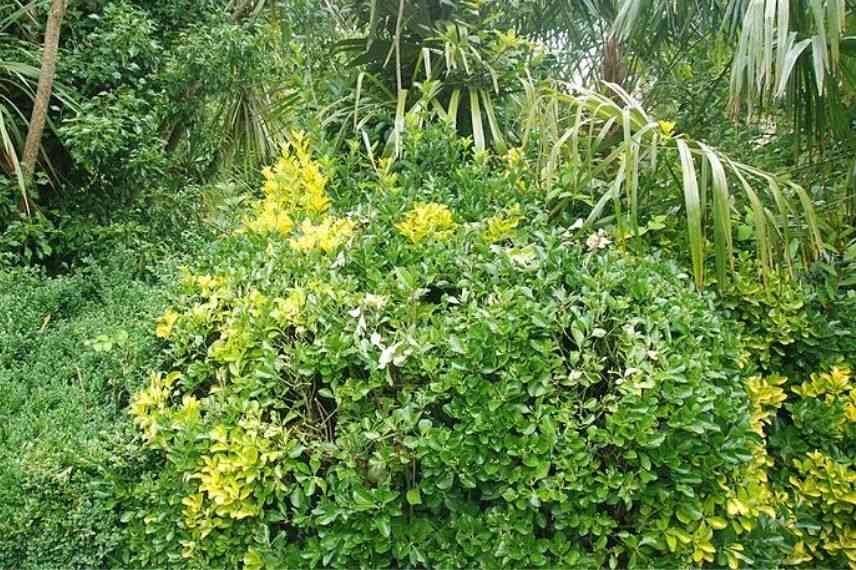
Euonymus japonicus (photo Wikipedia)
Discover other Hedge shrubs
View all →Available in 0 sizes
Available in 1 sizes
Available in 1 sizes
Available in 1 sizes
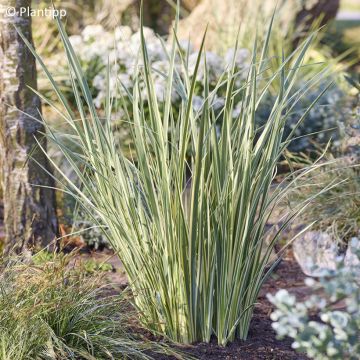
Available in 1 sizes
Available in 1 sizes
Available in 1 sizes
Available in 1 sizes
Available in 2 sizes
Available in 1 sizes
Eleagnus, a pollution-resistant screen plant
The Elaeagnus or oleaster is a bush with a dense silhouette and rapid growth, making it very suitable for pruning. To create a privacy hedge, opt for the Elaeagnus ebbingei or Ebbing’s oleaster, with its evergreen green foliage that has silver reflections. Some varieties also offer attractive variegated foliage.
This bush reaches 3 metres in height at ripeness, with a spread of 2 metres.
While its autumn flowering is rather modest, it has the advantage of being delicately scented and attracting bees. It is followed by small decorative and edible fruits.
Elaeagnus plants grow easily in all types of soil, even the poorest and most calcareous, and in all exposures. Easy to care for, they tolerate drought, wind, and cold. Also resistant to pollution, they can create a green privacy hedge in urban gardens.
To learn all about their cultivation requirements, discover our guide “Elaeagnus or oleaster: planting, pruning, maintenance tips.”
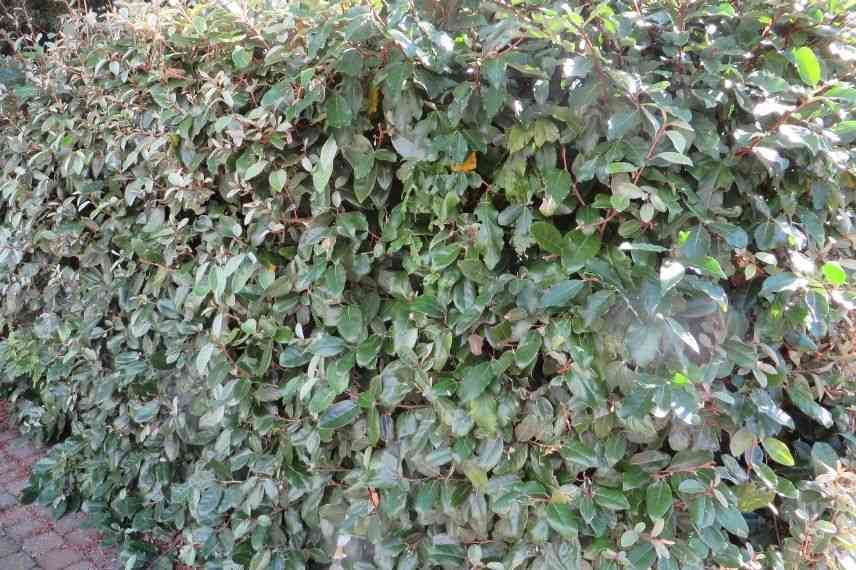
Elaeagnus ebbingei
Read also
7 trees for a windbreakPhotinia, a beautiful coloured foliage
Evergreen shrubs for hedges, photinias are known for their ease of maintenance, rapid growth, and tolerance to pruning.
Their elegant, highly decorative foliage changes colour throughout the seasons. Photinia fraseri ‘Red Robin’ is one of the most popular varieties, with its young copper-red leaves turning dark green. However, other cultivars are also worth discovering, such as ‘Carré Rouge’, with its even denser colourful foliage, or ‘Pink Marble’, featuring its stunning variegated leaves.
The spring flowering consists of creamy-white umbels sometimes tinged with pink.
Tolerant, photinias can withstand drought, pollution, and alkaline conditions, thriving in full sun or partial shade. They are also quite hardy, down to about -15°C.
Find all our planting tips in the section “Photinia: planting, pruning, and maintaining.”
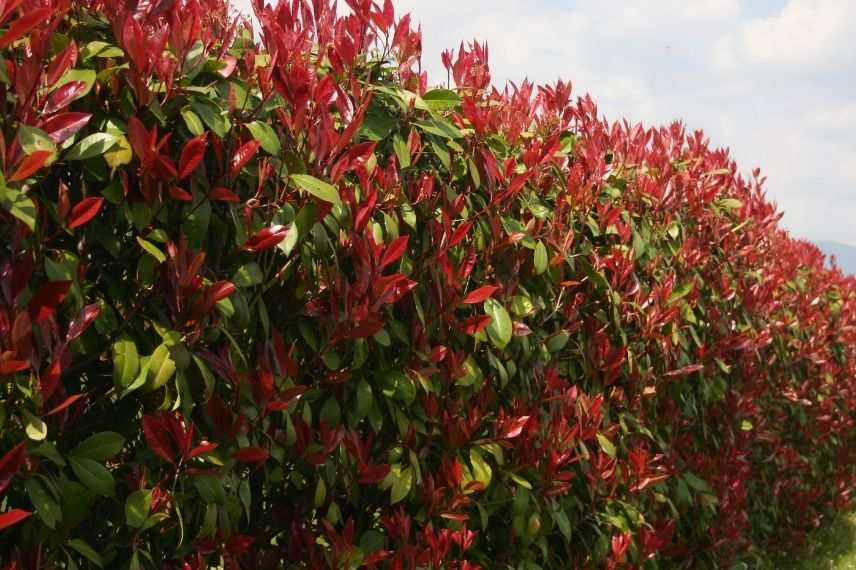
The famous Photinia fraseri ‘Red Robin’
Escallonia, for a flowering privacy hedge
The escallonia is a bush for mild climates, valued for its abundant flowering and beautiful evergreen foliage. Tolerant of sea spray and hardy down to about -10°C, it is perfect for a privacy hedge in a seaside garden.
Throughout the summer, the bush produces beautiful tubular flowers in pink, white, or more rarely red. Ideal for quickly creating a stunning flowering green screen! For this purpose, choose varieties that reach at least 2 metres in height, such as ‘Dart’s Rosy Red’, ‘Donard Seedling’, or the Escallonia laevis ‘Gold Ellen’, remarkable for its bright golden yellow foliage speckled with green.
The escallonia is not very susceptible to diseases and is easy to maintain. It prefers a sunny position to flower well, sheltered from draughts.
To successfully grow your escallonias, find all our tips in the file “Escallonia: planting, pruning, maintenance.”
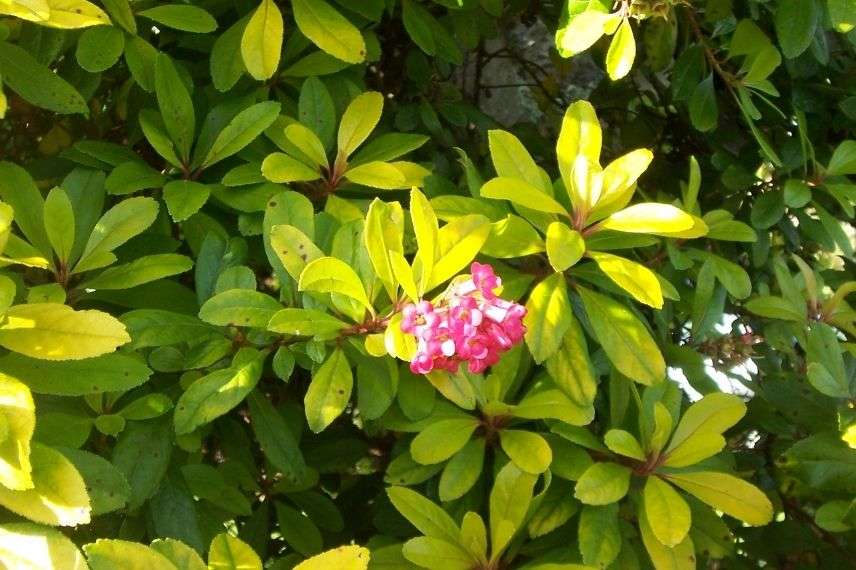
Escallonia laevis ‘Gold Ellen’ (photo wallygrom)
The thorny barberry, a defensive screen
Thebarberry is a flamboyant hedge bush. Thanks to its thorns, it also forms a true defensive plant barrier.
For a privacy hedge, choose evergreen varieties that reach at least 2 metres in height and spread, such as Berberis darwinii, Berberis x stenophylla, or Berberis lologensis ‘Apricot Queen’. These varieties offer a very colourful spring flowering, followed by the production of adorable decorative fruits.
These bushy shrubs tolerate pruning well, have a rapid growth rate, and are relatively low-maintenance. Hardy, they tolerate all types of soil and exposure, requiring no upkeep: they are among the foolproof choices!
Find all our growing tips in the plant sheet “Berberis, barberry: planting, pruning, and maintenance.”
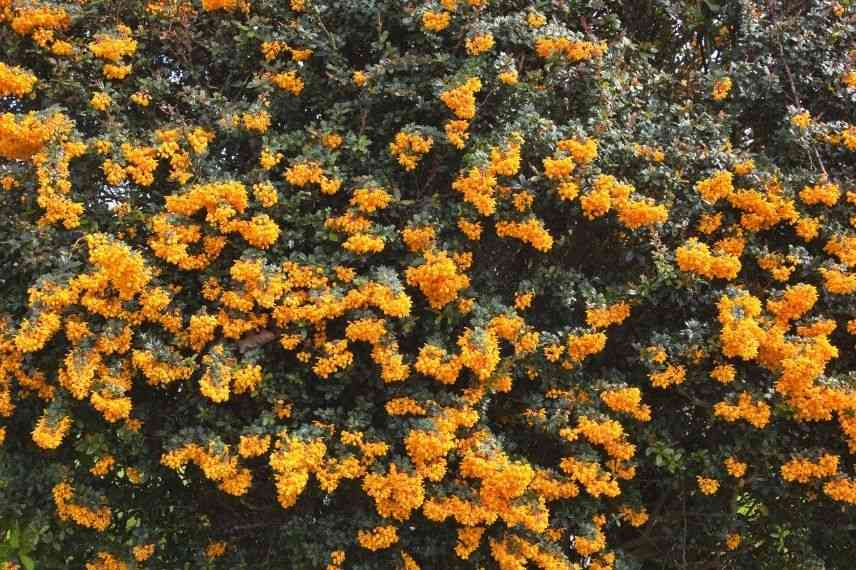
Berberis darwinii
Bamboo, a graphic and exotic screening plant
If we are offering you bamboos in this selection, let’s clarify right away that we recommend opting for non-running varieties, known as “clumping”. Their more compact silhouettes and less invasive roots will prevent them from proliferating in the garden or requiring the installation of a rhizome barrier.
Bamboos are well-suited for creating privacy hedges thanks to their dense and evergreen foliage, rapid growth, and natural resilience. We love them for the graphic and vertical touch they bring, as well as their exotic appeal.
Easy to maintain, tolerant, and hardy, they will quickly create a true protective green screen. Medium varieties, measuring approximately 2 to 5 metres, will be ideal for this use.
And to successfully cultivate your bamboos, visit our dedicated section “Bamboos: planting, pruning, maintaining.”
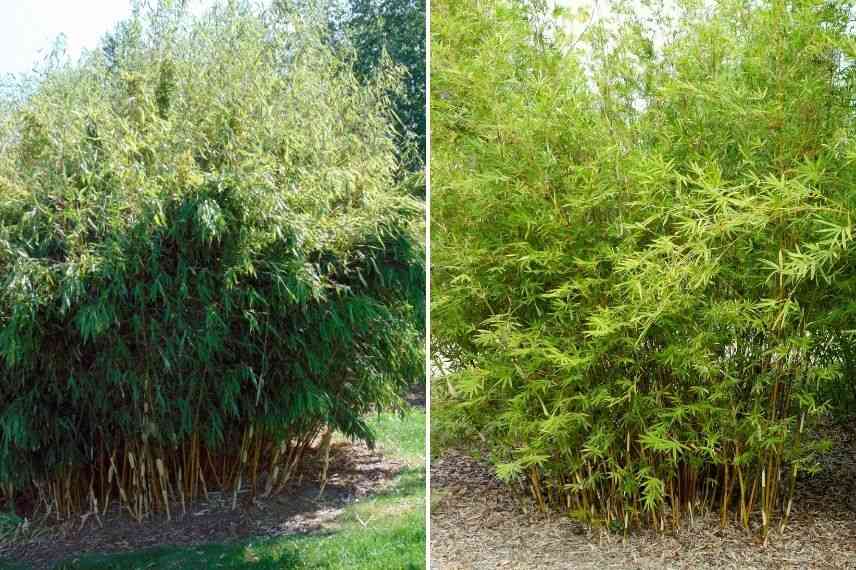
Fargesia rufa and Bambusa multiplex ‘Alphonse Karr’ (photo Wikipedia)
Viburnums, reliable choices
Very popular, yet always appreciated for their qualities: the viburnums. Abundant fragrant flowering, decorative fruits, good hardiness, and ease of cultivation have earned them their reputation.
The evergreen varieties will make perfect living hedges to shield from prying eyes. Among them, we find the famous laurustinus, as well as Viburnum rhytidophyllum with its very dense foliage, or Viburnum lucidum, which adorns itself with red to purple hues in autumn and winter.
Find all our cultivation tips in the dedicated section “Viburnum: planting, pruning, and cultivating.”
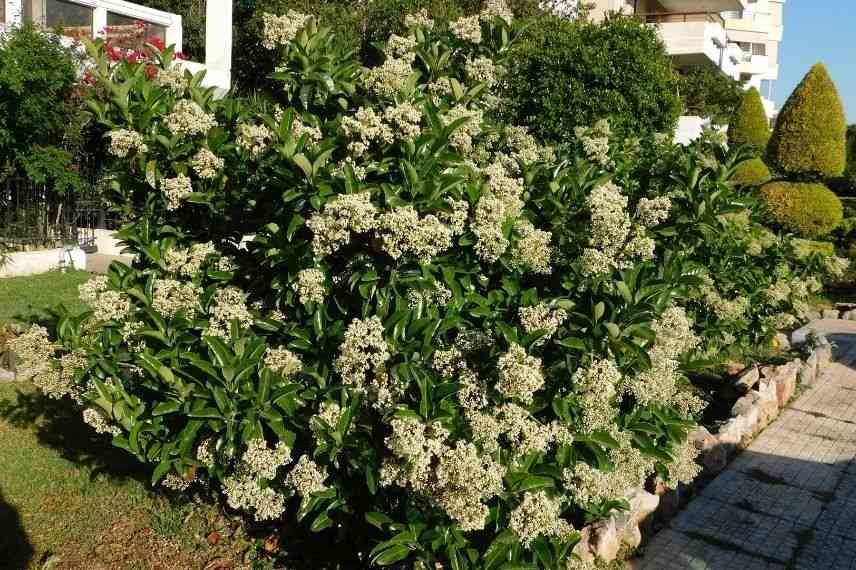
Viburnum lucidum
- Subscribe!
- Contents

































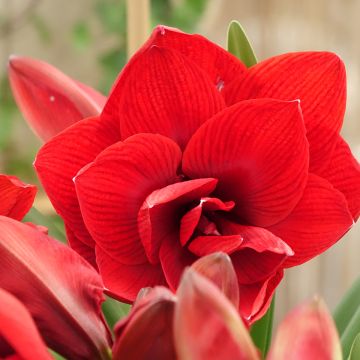


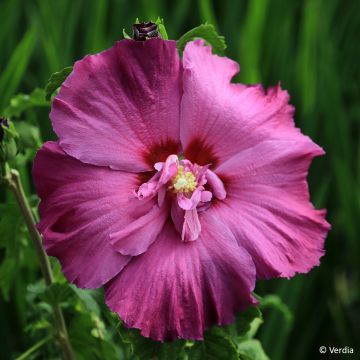

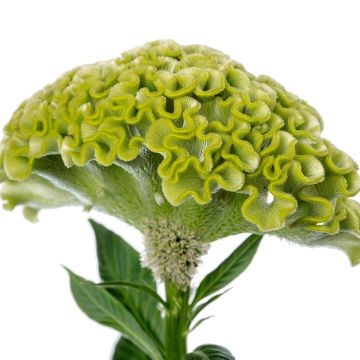
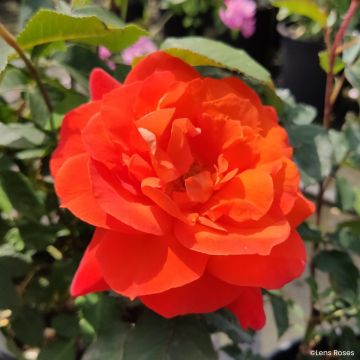

Comments